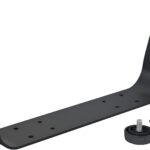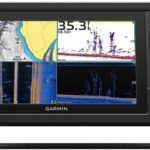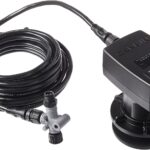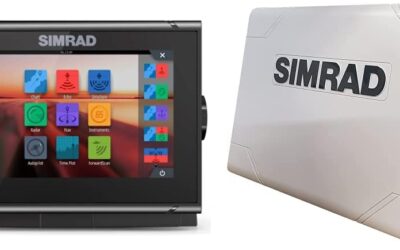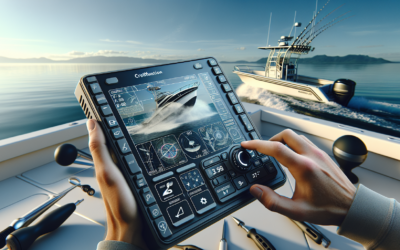In this article, you will explore the world of fish finders and dive into the exciting realm of connectivity options available in these devices. With a focus on the assessment of GPS, Wi-Fi, and other integrated features, we will provide you with valuable insights and a comprehensive understanding of how these advancements can enhance your fishing experience. So, buckle up and get ready to uncover the wonders of connectivity in fish finders!

Connectivity in Fish Finders: Assessing GPS, Wi-Fi, and Other Integrated Features
Welcome to this comprehensive article on connectivity in fish finders. Fish finding technology has rapidly evolved, and today’s fish finders come with various integrated features that enhance the fishing experience. In this article, we will assess the benefits and limitations of GPS, Wi-Fi, Bluetooth, cellular network, and multi-band connectivity in fish finders. We will also address concerns about privacy and data security in connected fish finders.
1. GPS technology in fish finders
1.1 How GPS works in fish finders
GPS, or Global Positioning System, is a satellite-based navigation system that allows fish finders to determine your precise location on Earth. The fish finder uses signals from a network of satellites to triangulate your position by measuring the time it takes for the signals to reach your device’s receiver. By combining signals from multiple satellites, GPS can accurately calculate your latitude and longitude.
1.2 Utilizing GPS for accurate positioning
The integration of GPS technology in fish finders enables anglers to navigate the waters with unparalleled accuracy. With GPS, you can mark specific locations such as fishing hotspots, underwater structures, or areas where you have had successful catches. This feature allows you to return to those locations at any time, ensuring you don’t miss out on opportunities.
1.3 Enhancing fish finding capabilities with GPS
In addition to precise positioning, GPS integration in fish finders provides valuable data on your boat’s speed, direction, and track. This information allows you to analyze your fishing patterns and make informed decisions about where to cast your line. By monitoring your movement and speed, you can identify areas where fish are likely to be active and adjust your strategy accordingly.
1.4 Important considerations for GPS-enabled fish finders
When considering a GPS-enabled fish finder, it’s essential to ensure the device has a reliable and accurate GPS receiver. Look for features like high-sensitivity receivers that can maintain a strong signal even in challenging environments. Additionally, consider the screen size and display quality as it impacts the readability of GPS information while on the water.
2. Advantages of GPS integration in fish finders
2.1 Real-time tracking and mapping of fishing hotspots
One of the significant advantages of GPS integration in fish finders is the ability to track and map fishing hotspots in real-time. As you navigate the water, your fish finder continuously updates your position and stores it as waypoints on a map. This feature allows you to create a visual record of your fishing spots, making it easier to revisit successful locations.
2.2 Precise navigation and route planning for anglers
GPS technology enables precise navigation and route planning. Fish finders with GPS integration can display your current location, track your movement, and provide visual cues for navigation. Whether you’re exploring a new fishing spot or returning to a familiar one, GPS can help you navigate with confidence and avoid hazards.
2.3 Access to detailed environmental data through GPS integration
Fish finders with GPS integration often offer additional environmental data, such as water temperature, depth, and speed. By combining this information with GPS coordinates, anglers can gain insights into fish behavior and adjust their fishing techniques accordingly. This rich dataset can significantly enhance the fishing experience and increase the chances of a successful catch.
2.4 Facilitating data sharing and community-based fishing information
GPS integration in fish finders facilitates data sharing among anglers. With the ability to mark and share waypoints, anglers can contribute to community-based fishing information, creating an extensive database of fishing hotspots, species caught, and other relevant details. By accessing this shared information, anglers can tap into collective knowledge and improve their fishing outcomes.
3. Limitations of GPS in fish finders
3.1 Signal interference and accuracy challenges
While GPS is generally reliable, it can face challenges in certain scenarios. Signal interference from tall buildings, dense vegetation, or significant obstructions can limit the GPS accuracy, making it challenging to pinpoint your exact location. Additionally, multiple satellites visibility might be compromised in narrow waterways or under heavy tree covers, impacting the accuracy of the positioning data.
3.2 Dependence on satellite coverage and signal strength
GPS relies on satellite coverage and strong signal strength to function accurately. In remote areas or offshore fishing locations, satellite signals may be weaker or non-existent, affecting GPS performance. It’s crucial to consider the fishing environments you frequent and ensure that GPS coverage is available in those areas.
3.3 Issues of battery drain and power consumption
The use of GPS technology in fish finders can contribute to increased power consumption and potential battery drain. Continuous use of GPS tracking and mapping features may reduce the battery life of the device, requiring regular recharging or the availability of power sources on the boat. It’s essential to factor in power management strategies to optimize the battery life while utilizing GPS functionality.
3.4 GPS limitations in challenging fishing environments
In challenging fishing environments such as ice fishing or heavy vegetation, GPS integration may have limitations. The accuracy of GPS positioning may be compromised due to the interference caused by ice or dense foliage. Additionally, the signals from satellites bouncing off the ice or vegetation can result in distorted readings. Anglers should be aware of these limitations and consider alternative navigation methods in such conditions.
4. Wi-Fi connectivity in fish finders
4.1 Understanding Wi-Fi integration in fish finders
Wi-Fi integration in fish finders allows for wireless connectivity and data transfer. By connecting your fish finder to a Wi-Fi network, you can access various features and functionalities that enhance your fishing experience. Wi-Fi-enabled fish finders can communicate with other devices, applications, and online platforms, opening up a world of possibilities for anglers.
4.2 Utilizing Wi-Fi for wireless data transfer
One of the primary benefits of Wi-Fi integration is the ability to wirelessly transfer data from your fish finder to other devices. This feature enables you to view and analyze the data on a larger screen such as a smartphone, tablet, or computer, providing a more detailed and comprehensive view of the underwater environment. Wi-Fi data transfer also allows for easy sharing of fishing data and insights with other anglers.
4.3 Enhancing fish finder functionality through Wi-Fi
Wi-Fi integration expands the functionality of fish finders by connecting them to various applications and online platforms. You can access weather forecasts, tidal data, and other relevant information in real-time, helping you make informed fishing decisions. Additionally, some Wi-Fi-enabled fish finders provide the ability to download software updates, ensuring that your device remains up-to-date with the latest features and improvements.
4.4 Considerations for Wi-Fi-enabled fish finders
When considering a Wi-Fi-enabled fish finder, it’s crucial to assess its compatibility with your existing devices and Wi-Fi networks. Ensure that the fish finder supports commonly used Wi-Fi standards and encryption protocols to maintain secure connections. Additionally, check the range and signal strength of the Wi-Fi connectivity to ensure it meets your fishing needs.
5. Benefits of Wi-Fi integration in fish finders
5.1 Seamless connectivity for real-time data syncing
Wi-Fi integration provides seamless connectivity, allowing fish finders to sync data in real-time. By connecting to a Wi-Fi network, your fish finder can transmit data such as waypoints, tracks, and sonar readings to other devices or cloud-based platforms instantly. This real-time syncing ensures that you have access to the latest information and can easily synchronize your fishing data across multiple devices.
5.2 Wireless control and remote access capabilities
With Wi-Fi integration, anglers can enjoy wireless control and remote access capabilities. Some fish finders allow you to control the device remotely through a smartphone or tablet, providing convenience and flexibility while on the water. This feature enables you to adjust settings, view live sonar data, or mark waypoints from a distance, enhancing the overall fishing experience.
5.3 Integration with other devices and applications
Wi-Fi integration enables fish finders to seamlessly integrate with other devices and applications. You can connect your fish finder to compatible smartphones, tablets, or computers, expanding the display options and leveraging the processing power of these devices. Integration with applications such as mapping tools, weather services, or fish species databases enhances your fishing capabilities by providing comprehensive and real-time information.
5.4 Sharing fishing data and insights among anglers
Wi-Fi-enabled fish finders foster collaboration and data sharing among anglers. By connecting to a Wi-Fi network, you can share fishing data, waypoints, and catch information with fellow anglers in real-time. This not only creates a sense of community but also enhances the collective knowledge base, benefiting all anglers by providing valuable insights and increasing the chances of successful catches.
6. Challenges of Wi-Fi in fish finders
6.1 Signal range limitations and connectivity issues
Wi-Fi connectivity in fish finders may face signal range limitations, particularly in open water or large fishing grounds. The distance over which a fish finder can reliably connect to a Wi-Fi network may vary depending on environmental factors, such as interference from other electronic devices or obstacles on the boat. It’s important to consider the signal range needs and select a Wi-Fi-enabled fish finder that meets those requirements.
6.2 Potential security vulnerabilities in Wi-Fi networks
While Wi-Fi networks offer convenience and connectivity, they may also introduce security vulnerabilities. It’s crucial to secure your Wi-Fi network with a strong password and encryption protocols to prevent unauthorized access to your fish finder and personal information. Additionally, be cautious when connecting to public Wi-Fi networks, as they may be susceptible to hacking or data breaches.
6.3 Power consumption concerns in Wi-Fi-enabled fish finders
Wi-Fi connectivity can have an impact on power consumption in fish finders. Continuous use of Wi-Fi functionality, such as data syncing or streaming, may drain the device’s battery at a faster rate. It’s advisable to have sufficient power backup or charging options available on your boat to ensure uninterrupted usage of Wi-Fi-enabled fish finders.
6.4 Compatibility and interoperability challenges
Compatibility issues may arise when integrating Wi-Fi-enabled fish finders with other devices or applications. It’s important to ensure that the fish finder supports the required Wi-Fi standards and protocols to establish a seamless connection. Compatibility with operating systems and software applications should also be considered to ensure a smooth and hassle-free user experience.
7. Bluetooth connectivity in fish finders
7.1 How Bluetooth integrates with fish finders
Bluetooth integration allows fish finders to establish short-range wireless connections with other devices. By connecting your fish finder to a Bluetooth-enabled device such as a smartphone or tablet, you can transfer data, control the fish finder remotely, and access additional features and functionalities.
7.2 Connecting and pairing devices through Bluetooth
To establish a Bluetooth connection, you need to pair your fish finder with a compatible Bluetooth-enabled device. The pairing process involves enabling Bluetooth on both devices, searching for available devices, and selecting the fish finder from the list. Once paired, the devices can communicate and share data wirelessly.
7.3 Enhancing user experience with Bluetooth connectivity
Bluetooth connectivity enhances the user experience by providing seamless connectivity and convenience. Anglers can use their smartphones or tablets as extended displays for the fish finder, allowing for a larger and more detailed view of sonar data and maps. Bluetooth connectivity also enables anglers to receive notifications, control settings, and access advanced features from their mobile devices.
7.4 Considerations for Bluetooth-enabled fish finders
When considering a Bluetooth-enabled fish finder, ensure compatibility with your existing devices and operating systems. Check if the fish finder supports the required Bluetooth version and profiles to establish optimal connectivity. Additionally, consider the range and signal stability of the Bluetooth connection to meet your fishing needs.
8. Pros and cons of Bluetooth integration in fish finders
8.1 Increased flexibility and device compatibility
Bluetooth integration in fish finders offers increased flexibility and device compatibility. Anglers can connect and control the fish finder using their personal smartphones or tablets, eliminating the need for dedicated display units. This flexibility allows you to use Bluetooth-enabled fish finders with multiple devices, making it a convenient choice for anglers who prefer to customize their fishing setup.
8.2 Energy-efficient connectivity and reduced power consumption
Bluetooth connectivity is known for its energy efficiency, making it an attractive option for fish finders. Compared to Wi-Fi or cellular network connectivity, Bluetooth consumes relatively less power, conserving the device’s battery life. This energy efficiency ensures a longer runtime, allowing anglers to use Bluetooth-enabled fish finders for extended fishing trips without worrying about frequent recharging.
8.3 Limitations of Bluetooth range and signal stability
Bluetooth connectivity is limited to short-range communication, typically up to 100 meters. While this range is generally sufficient for most fishing scenarios, it may limit the connectivity options when fishing in larger bodies of water or with significant distances between devices. Additionally, Bluetooth signals can be affected by interference from other electronic devices or physical obstacles on the boat, leading to potential signal instability.
8.4 Security and privacy considerations with Bluetooth
As with any wireless technology, security and privacy considerations are essential when using Bluetooth-enabled fish finders. Ensure that you pair your devices with trusted and secure connections to prevent unauthorized access to your fish finder or personal information. Regularly update the device’s software and firmware to address any security vulnerabilities and follow best practices for data protection.
15. Addressing concerns about privacy and data security in connected fish finders
15.1 Potential risks and vulnerabilities in connected fish finders
Connected fish finders, whether through GPS, Wi-Fi, Bluetooth, or cellular network integration, introduce potential risks and vulnerabilities related to privacy and data security. These risks include unauthorized access to personal information, fishing locations, or device controls. Hackers or malicious actors could exploit vulnerabilities to compromise the security of connected fish finders and disrupt fishing experiences.
15.2 Ensuring data protection and privacy measures
To address concerns about privacy and data security in connected fish finders, manufacturers should prioritize data protection measures. This includes implementing strong encryption protocols, secure authentication processes, and regular software updates. Manufacturers must also educate users on best practices for data security, such as setting strong passwords and avoiding unsecured Wi-Fi networks.
15.3 Compliance with data regulations and legal frameworks
Manufacturers of connected fish finders must ensure compliance with data protection regulations and legal frameworks. This includes adhering to applicable laws regarding the collection, storage, and sharing of data. Users should be informed about the types of data collected, the purposes for which it is used, and the mechanisms in place to protect their privacy and comply with relevant regulations.
15.4 Responsible data sharing and user consent
Responsible data sharing practices and obtaining user consent are crucial in connected fish finders. Manufacturers should provide clear information about how data will be shared, with whom, and for what purposes. Users should have the right to control their data and provide informed consent for data sharing. Transparency and user empowerment are key to building trust in connected fish finders.
In conclusion
Connectivity in fish finders has opened up a world of possibilities for anglers. Whether it’s GPS for precise navigation, Wi-Fi for seamless data transfer, Bluetooth for remote control, or cellular network integration for broader connectivity, these features enhance the fishing experience in various ways. However, it’s essential to consider the benefits and limitations of each connectivity option. Additionally, manufacturers and users must address concerns about privacy and data security to ensure responsible and secure use of connected fish finders. By harnessing the power of integrated features, anglers can take their fishing adventures to new heights and improve their chances of landing the perfect catch.

